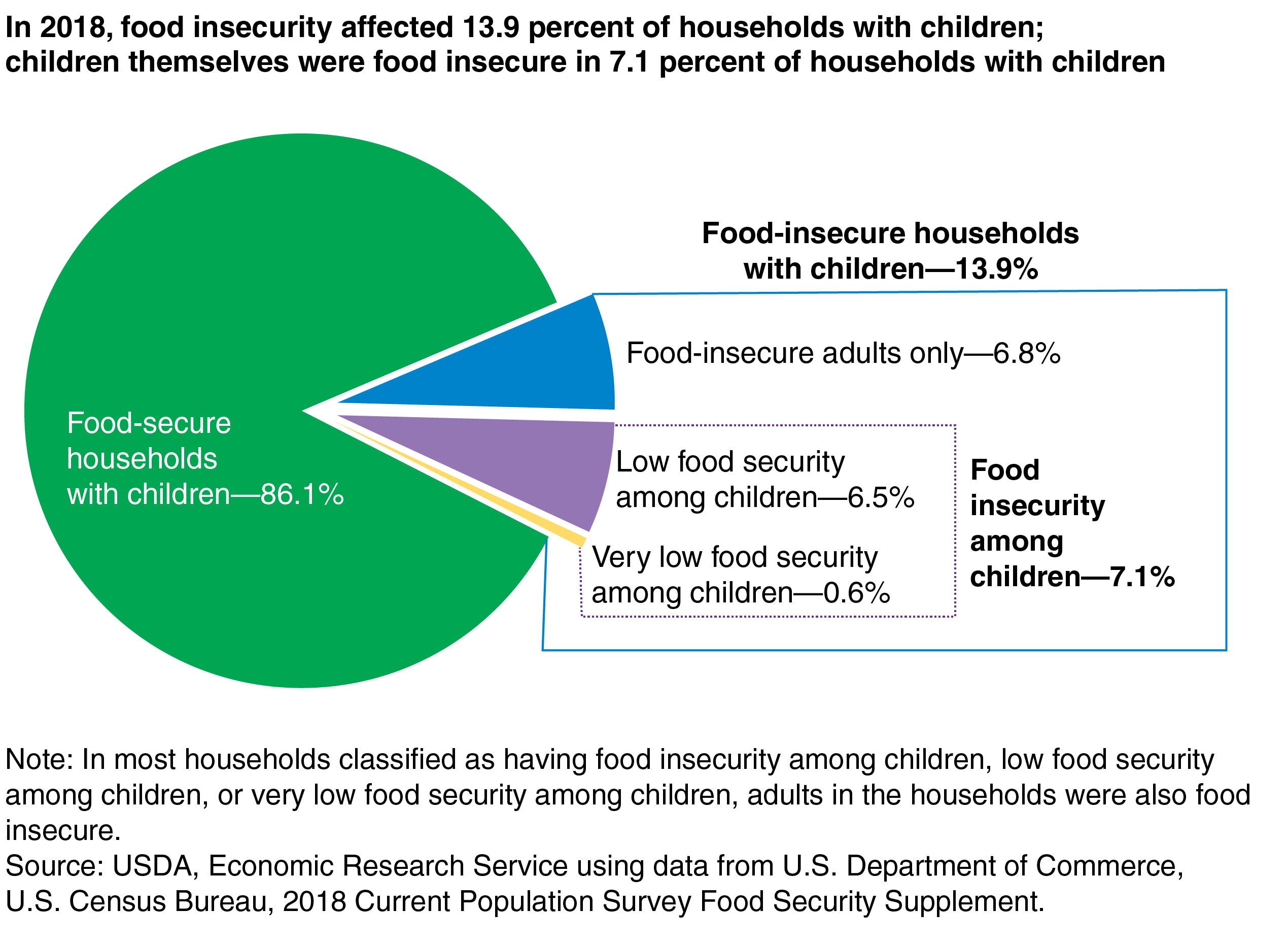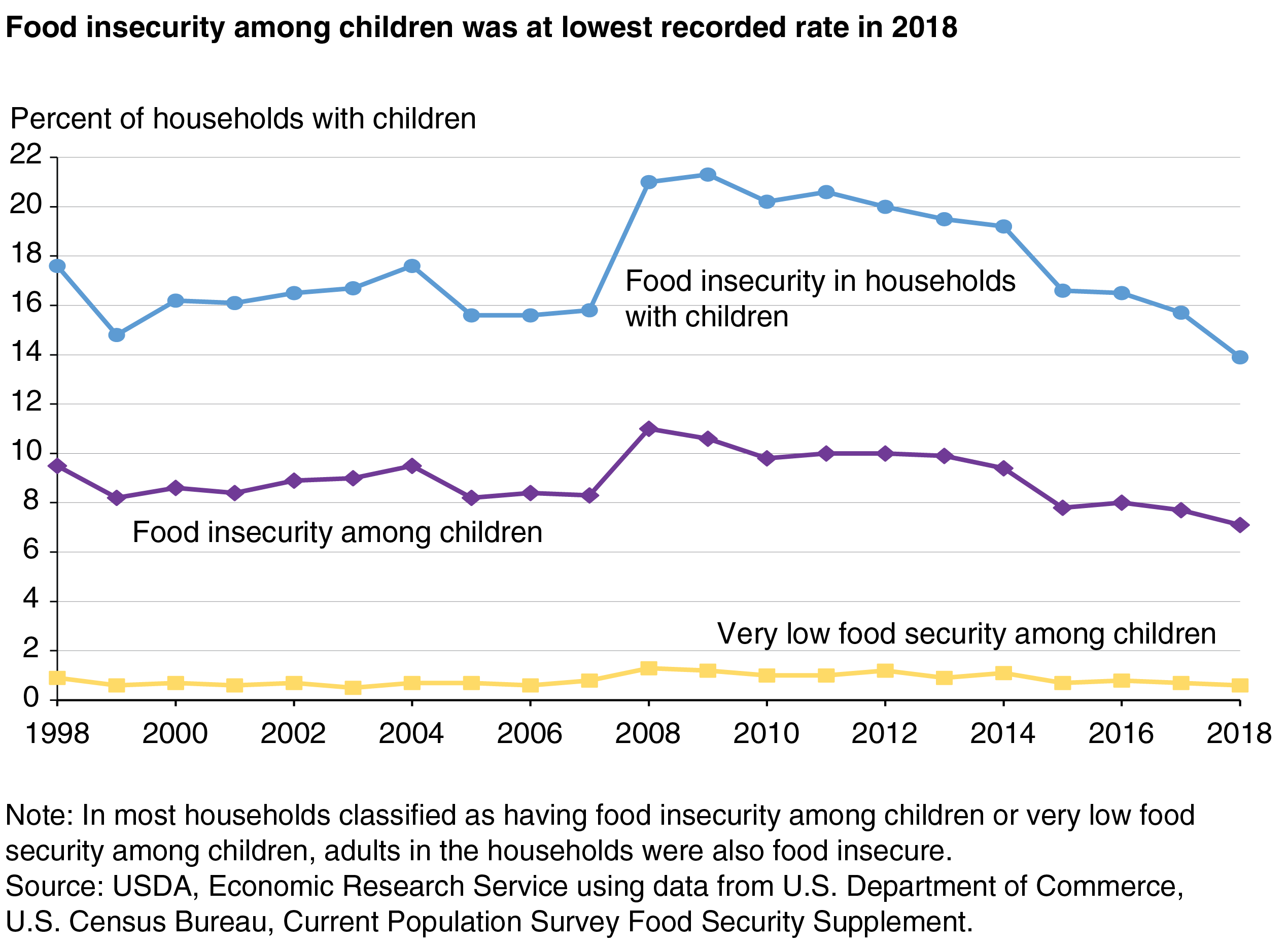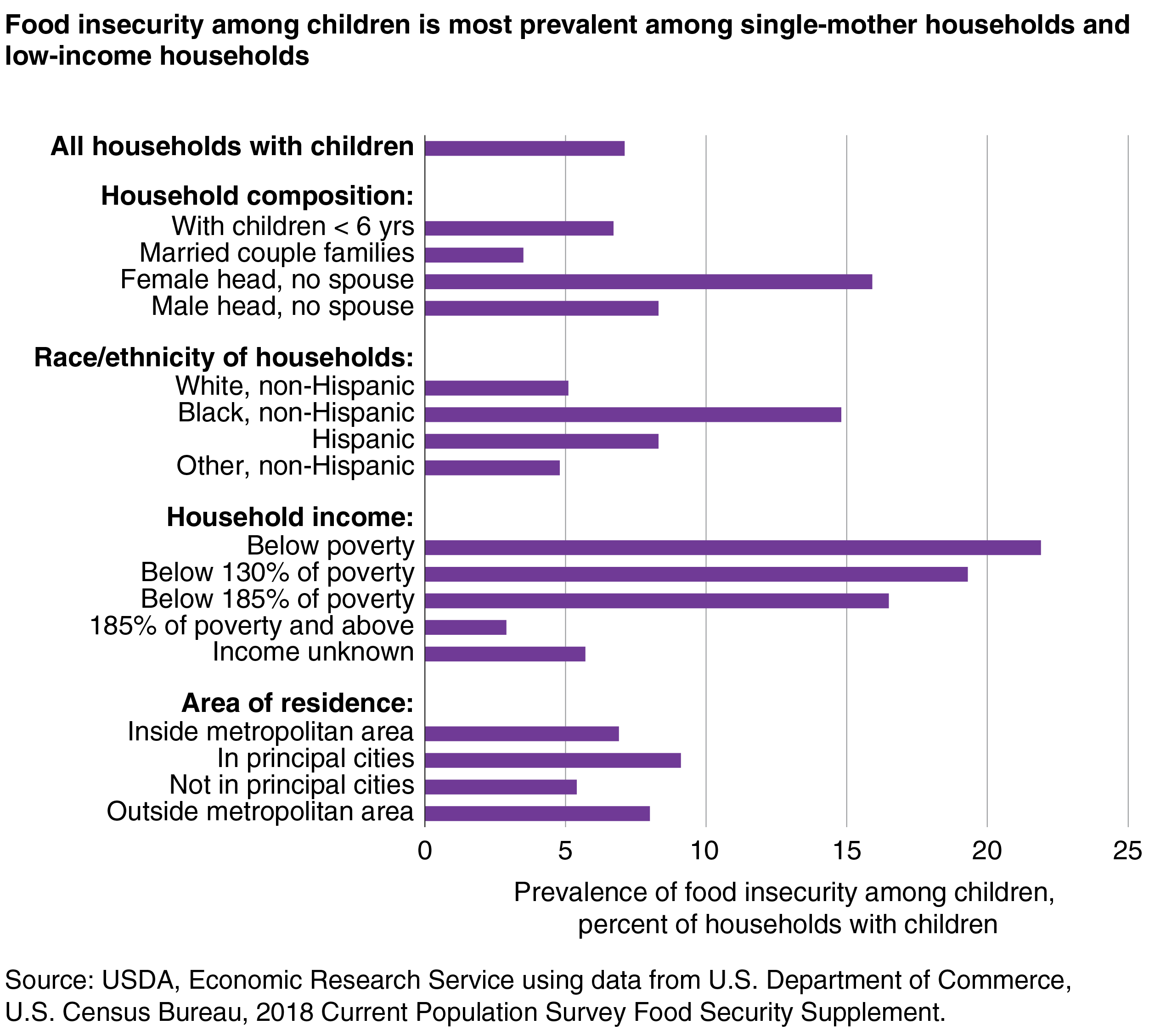
Food Insecurity Among Children Has Declined Overall But Remains High for Some Groups
- by Alisha Coleman-Jensen
- 12/2/2019
Food security—access at all times to enough food for an active, healthy life—provides an important foundation for nutrition and health. Food security is especially important for children. The nutritional content of their diets affects not only their current health, but also their physical, mental, and social development—and thus, their future health and well-being. Prior research has shown that children in food-insecure homes, where parents and caregivers struggle to put enough food on the table, are more likely to have adverse outcomes, such as more chronic health conditions, slower progress in math and reading, and more difficulties with social development than do otherwise similar children in food-secure homes.
USDA monitors the extent and severity of food insecurity in U.S. households through the ERS-sponsored Food Security Supplement, administered as part of the U.S. Census Bureau’s annual Current Population Survey. The data obtained from the supplement are used to understand trends in U.S. food insecurity and to identify demographic and economic characteristics of groups more vulnerable to food insecurity. While the overall prevalence of food insecurity among children has declined since 2011, some subpopulations continue to be at higher risk for child food insecurity and its associated outcomes. Rates of food insecurity among children for households headed by single mothers and for households headed by Black, non-Hispanic adults in 2018 were more than twice the national rate.
How Is Food Insecurity Among Children Measured?
Food insecurity among U.S. children is assessed by responses to a series of questions in the annual Food Security Supplement. Adult survey respondents are asked eight questions about the food situation for children in the household. The questions cover a variety of behaviors and conditions ranging in severity. For example, the range went from, “‘We relied on only a few kinds of low-cost food to feed our children because we were running out of money to buy food.’ Was that often, sometimes, or never true for you in the last 12 months?” to “In the last 12 months, did you ever cut the size of any of the children’s meals because there wasn’t enough money for food?” to “In the last 12 months, did any of the children ever not eat for a whole day because there wasn’t enough money for food?” Households affirming two or more of these eight questions are classified as having food insecurity among children. Food insecurity can be further divided by the severity of food hardships experienced. Households affirming two to four items are classified as having low food security among children. Households affirming five or more are classified as having very low food security among children.
The share of households affirming a question describing a food-insecurity behavior or condition declines as the conditions and behaviors become more severe. Of all U.S. households with children in 2018, 11.9 percent indicated they relied on a few kinds of low-cost food to feed children because they were running out of money for food and 1.3 percent affirmed that they cut the size of children’s meals because there was not enough money for food. In 2018, 0.4 percent of U.S. households with children indicated that children had skipped meals and 0.1 percent reported that children had not eaten for a whole day at some time in the last year because there was not enough money for food.
Food Insecurity in Households With Children Has Been on a Downward Trend…
In 2018, 86.1 percent of the 37.6 million U.S. households with children under age 18 were food secure. The remaining 13.9 percent of households with children were food insecure at some time during the year. In these food-insecure households with children, someone in the household was food-insecure, but not necessarily the children. Parents and caregivers often are able to maintain normal or near-normal diets and meal patterns for their children, even when the parents themselves are food insecure. In about half of food-insecure households with children in 2018, only adults were food insecure (6.8 percent of households with children).
However, in 2.7 million households—7.1 percent of households with children—both children and adults were food insecure in 2018. This 7.1 percent of households is described as having food insecurity among children, where parents report that children have reductions in dietary quality and quantity. In 0.6 percent of households with children (220,000 households), children experienced very low food security—parents and caregivers reported that children were hungry, skipped a meal, or did not eat for a whole day because there was not enough money for food. These households are described as having very low food security among children.
In 2018, the prevalence of food insecurity in households with children was 13.9 percent—a statistically significant decline from 15.7 percent in 2017. Food insecurity in households with children (again, households with children where only the adults or both children and adults were food insecure) in 2018 was lower than in any year back to 1998.
The prevalence of food insecurity among children, where both children and adults were food insecure, was also at the lowest level compared with any year back to 1998. The prevalence of households with food insecurity among children was 7.1 percent in 2018—not significantly different from the prevalence in 2017 (7.7 percent) or in 2015 (7.8 percent).
The prevalence of the more severe very low food security among children was essentially unchanged from 2017 to 2018, and similar to rates in 2016 and 2015, and in 1999 through 2007. However, 2018’s prevalence of very low food security among children was significantly lower than rates in 2008 through 2014.
…But Food Insecurity Among Children Was Higher Than the National Average for Single-Mother-Headed Households and Low-Income Households
Despite these improving trends showing declining food insecurity rates among children, some population subgroups continue to have rates of food insecurity among children that are well above the national average. Households headed by single mothers are especially vulnerable to food insecurity. In 2018, 15.9 percent of single-mother-headed households with children experienced food insecurity among children. Households headed by Black, non-Hispanic adults also faced higher-than-average food insecurity rates, with 14.8 percent having food insecurity among children. Both of these are more than twice the national prevalence.
Income is a key predictor of food insecurity. Among households with income below the Federal poverty line, 21.9 percent had food insecurity among children, more than three times the national prevalence. Households in principal cities of metropolitan areas also face higher food insecurity rates, with 9.1 percent of principal-city households having food insecurity among children.
This article is drawn from:
- Coleman-Jensen, A., Rabbitt, M.P., Gregory, C.A. & Singh, A. (2019). Household Food Security in the United States in 2018. U.S. Department of Agriculture, Economic Research Service. ERR-270.
- Coleman-Jensen, A., Rabbitt, M.P., Gregory, C.A. & Singh, A. (2019). Statistical Supplement to Household Food Security in the United States in 2018. U.S. Department of Agriculture, Economic Research Service. AP-081.
You may also like:
- Food Security in the U.S.. (n.d.). U.S. Department of Agriculture, Economic Research Service.





